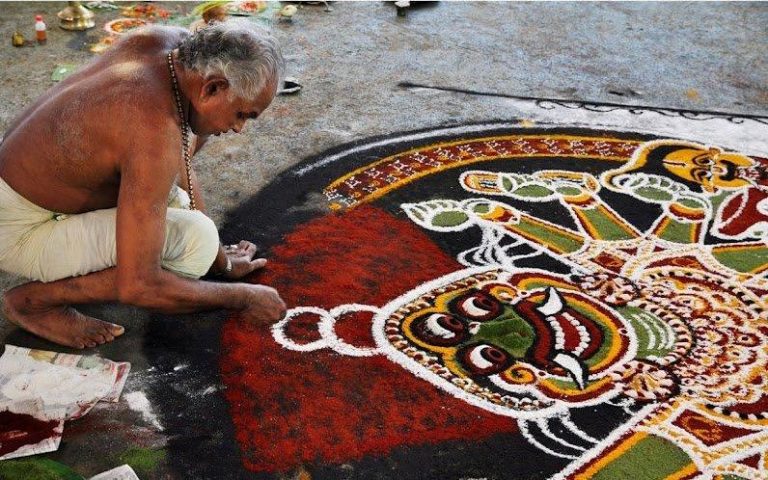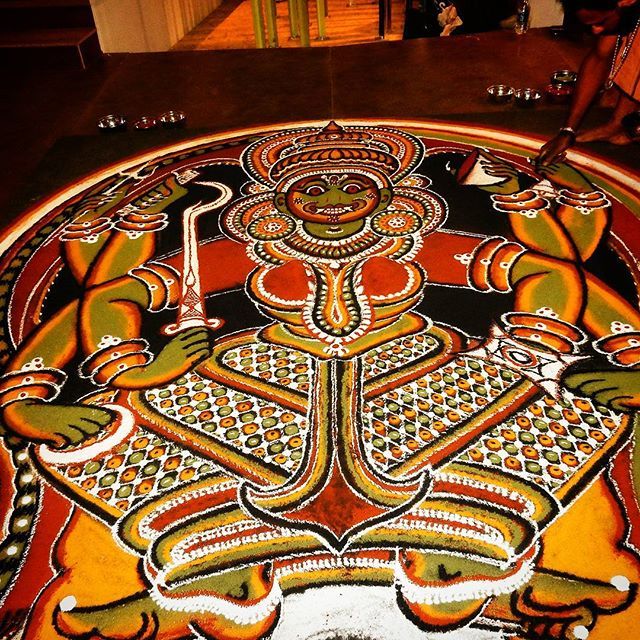Kerala, often referred to as “God’s Own Country,” is a land steeped in spirituality and cultural richness. Amidst its diverse traditions and rituals, there exists a captivating art form known as “Kalamezhuthu,” where intricate patterns representing deities are drawn on the floor using five different colors of powder. This sacred practice, often accompanied by traditional songs or “Pattu,” holds deep significance in Kerala’s religious and cultural landscape.
The Essence of Kalamezhuthu
Kalamezhuthu, in its essence, is a ritualistic art form that involves creating intricate and symmetrical patterns on the floor, typically inside temples, sacred groves, or special spaces dedicated to worship. The patterns are drawn using vibrant natural powders, which are traditionally derived from rice, turmeric, charcoal, and other natural substances. These powders are meticulously arranged to form images representing deities and divine beings.

Rituals and Practices
- Deity Invocation: The primary purpose of Kalamezhuthu is to invoke the presence of the deity being represented in the artwork. This is believed to invite divine blessings and protection.
- Color Symbolism: Each color used in the artwork holds symbolic significance. For instance, red symbolizes power and energy, while yellow represents knowledge and spirituality. These colors are chosen carefully to convey specific messages and invoke specific qualities associated with the deity.
- Precision and Skill: Kalamezhuthu artists, often from specialized communities, undergo rigorous training to master the art. The patterns they create are not random but adhere to precise measurements and symmetrical designs, showcasing their skill and devotion.
- Musical Accompaniment: The ritual of Kalamezhuthu is often accompanied by traditional songs or “Pattu.” These songs narrate tales of deities, extol their virtues, and invoke blessings. The music adds a spiritual dimension to the ritual and enhances the overall experience.
Spiritual Significance
- Devotion and Offering: Kalamezhuthu is considered a sincere offering to the deity, demonstrating the devotee’s dedication and devotion. The act of creating these intricate patterns is a form of worship in itself.
- Protection and Blessings: It is believed that by performing Kalamezhuthu and Pattu, the devotees seek the deity’s protection from negative forces and pray for blessings, prosperity, and well-being for their families and communities.
- Festival Celebrations: Kalamezhuthu is an integral part of many festivals in Kerala, especially in Bhadrakali temples. The elaborate floor art and vibrant songs add to the festive atmosphere and draw crowds of devotees.

Kalamezhuthu and Pattu are more than just artistic expressions; they are profound acts of devotion and reverence deeply woven into the cultural fabric of Kerala. These rituals, with their intricate designs, vivid colors, and spiritual significance, showcase the harmonious blend of art and spirituality that defines Kerala’s cultural heritage. They remind us of the enduring connection between the people of Kerala and the divine, as they continue to draw patterns to appease the gods and keep bad luck at bay.


